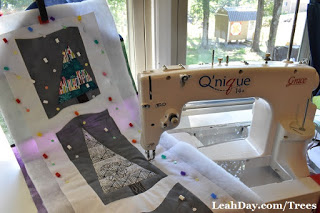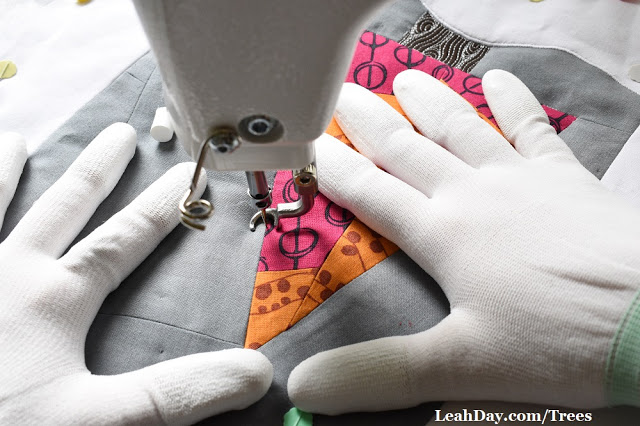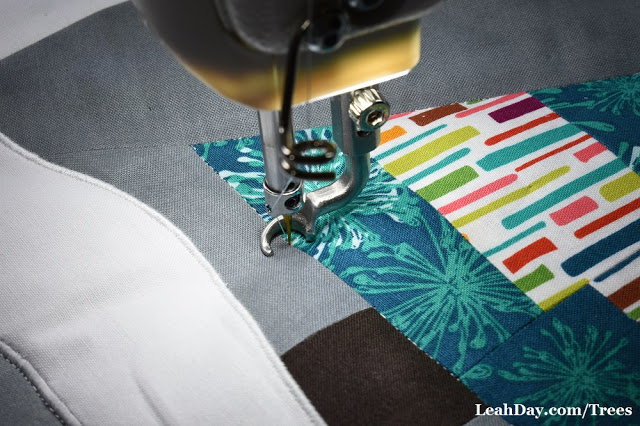Tips for Stitching in the Ditch

Whoa! Thank you all so much for your comments on Friday’s Twisted Square design video. I’ll definitely be making a video on how to quilt from reverse using the patterned backing fabric that I showed in the video.
I just need to pick the right quilt top for the job. I have over a dozen tops needing to be quilted, but I bet I’ll end up piecing something new just for this project!

Now I’m thinking about Christmas presents! I created this narrow Christmas tree quilt and the first step to quilting it is to stitch in the ditch. See how I stitched in the ditch to carefully with the Grace Qnique 14+ in this quilting tutorial.
Click here to check out more videos on the Grace Qnique sit down longarm.
I decided to use Superior Threads Magnifico to stitch in the ditch around the tree shapes and between the background and the border.

Click Here to find the free Wonky Christmas Tree pattern so you can make a quilt too!
I did have to slow down considerably in order to maintain good control over my stitches. The hopping of the foot was a little distracting but when I slowed down I barely noticed it moving.
No, I don’t have a stitch regulator on this machine. This is just my foot pressing the pedal very lightly. It’s tough to do at first because it’s hard to “feel” those slower speeds. If you’re quilting with shoes on right now, take them off! I always quilt barefooted so I can feel the foot pedal better and control the speed more accurately.
I’m able to do this mostly because of practice and I truly believe the more you quilt real quilts the better you will get. There’s something about quilting a real quilt that you care about that’s different than quilting a practice sandwich. I’ve been teaching online for years and definitely noticed students take practice sandwiches less seriously and often panic at the idea of quilting on the real thing.

I made a few mistakes and hopped out of the ditch a few times but I’m not ripping it out. I’m planning to add a lot of pretty quilting designs to the surface so hopefully that will hide my mistakes.
I’ve already started playing with some quilting designs to stitch over the Wonky Christmas Tree quilts and unfortunately hit a few snags with my design. Make sure to check back next Sunday to see what I’ve learned in this process.
Do you like stitching in the ditch? Do you hate it? What’s your preferred method for securing a quilt together at the beginning of a project? Share your thoughts in the comments below!
Let’s go quilt,
Leah Day

I like stitching in the ditch because of the way it makes the block look complete, but I also like to press my seams open, and I've heard many say ditching in an open seam weakens the seam, especially if you later wash it it'd get big holes. I know you like to press seams open … are you worried about that?
Yes, I've heard that too. I piece with a very tight stitch length – 1.5 mm – and that locks the pieces together very tight so I don't think it's bad to stitch right in the ditch. I've never seen it cause a problem for my quilts and I do think pressing seams open is important for more accurate blocks and an easier quilting process.
If your seam is open
1) there really is no ditch and
2) if you stitch right in the middle, you are sewing just over the threads that hold the piecing together, not on the fabric, and that has to weaken the construction. So no, I'd say never (haha) press seams open if you plan to stitch in the ditch.
If you stitch in the "downside" of a seam that has been pressed to the other side, and do it very closely, the puffiness of the quilt will tend to hide the ditch stitching. Most of the time you want the ditch stitching to not show, and that's another way of making it less visible. The "upside" will cover the ditch stitching. Heck, if you want the stitching to show, you wouldn't be trying to put it in the ditch.
Many years of quilting and long arming has taught me many lessons.
I'm curious why you didn't just use a walking foot to stitch in the ditch? Wouldn't that have provided more stability? Especially since it is a small project you can turn in the machine easily. Just curious.
PS: I have watched quite a few of your tutorials and I have to compliment you on the quality improvement, better lighting and sound.
A light Went on as I watched this video of how you could do bobbin work. Can't wait to see the quilting!
I am curious as to why you chose to use FMQ to SITD. Would it not have been easier to use the walking foot? Outside of practicing opportunities, what are the benefits of FMQ over the walking foot?
Also, let me say where you shine as a teacher is your attention to details. You give us the why's and not only the how to's.
Thank you.
That's great! I'm so glad you enjoyed the video. I choose to use this machine because it's the machine I most often use for personal projects. Most often my other machines have something work related in progress that's harder to move.
And…I do like showing that it's 100% possible to ditch with free motion quilting and with this machine in particular. If I was moving on to filling a design, I'd ditch, then start filling immediately and that would have saved a lot of thread breaks.
Absolutely! Walking foot quilting is much easier to stitch in the ditch, but it can also be slower. I guess I like the challenge and to show there are multiple ways to quilt anything. Thank you for the compliments! I really appreciate it!
Thank you for sharing your opinion Bobbi. This is a common question I receive about stitching in the ditch. The thing to realize is I always piece with tight stitch length 1.5 mm which locks the fabrics together very tightly. It's really hard to rip out the seams so I've never had an issue with stitching right in the ditch.
Many quilters like pressing to one side and I understand that. For me, I like the accuracy of having seams pressed open because my blocks end up exactly the right size and I like the look of quilting with the thread running right in the ditch. There's no single right or wrong method in quilting. A lot of different opinions and a lot of different techniques!
Hi Leah, I am a first time "comment person", but a long time follower and fan. Actually, I could hardly wait to purchase your bound copy of "365 Free Motion Quilting Designs" when you published it. I have really enjoyed reading all of the comments and opinions regarding Quilting in the Ditch, and Open Seams. I believe it is always good to go into something with an open mind, therefore you grow and continue to learn. I truly appreciate all of your online tutorials and your willingness to help educate us new FMQ's. Thanks so much.